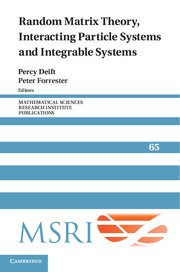Book contents
- Frontmatter
- Contents
- Preface
- Universality conjecture for all Airy, sine and Bessel kernels in the complex plane
- On a relationship between high rank cases and rank one cases of Hermitian random matrix models with external
- Riemann–Hilbert approach to the six-vertex model
- CLT for spectra of submatrices of Wigner random matrices, II: Stochastic evolution
- Critical asymptotic behavior for the Korteweg–de Vries equation and in random matrix theory
- On the asymptotics of a Toeplitz determinant with singularities
- Asymptotic analysis of the two-matrix model with a quartic potential
- Conservation laws of random matrix theory
- Asymptotics of spacing distributions 50 years later
- Applications of random matrix theory for sensor array imaging with measurement noise
- Convolution symmetries of integrable hierarchies, matrix models and τ-functions
- Universality limits via “old style” analysis
- Fluctuations and large deviations of some perturbed random matrices
- Three lectures on free probability
- Whittaker functions and relatedstochastic processes
- How long does it take to compute the eigenvalues of a random symmetric matrix?
- Exact solutions of the Kardar–Parisi–Zhang equation and weak universality for directed random polymers
- Replica analysis of the one-dimensional KPZ equation
- Asymptotic expansions for β matrix models and their applications to the universality conjecture
- KPZ scaling theory and the semidiscrete directed polymer model
- Experimental Realization Of Tracy–Widom Distributions And Beyond: Kpz Interfaces In Turbulent Liquid Crystal
- Random matrices: the four-moment theorem for Wigner ensembles
Convolution symmetries of integrable hierarchies, matrix models and τ-functions
Published online by Cambridge University Press: 29 May 2025
- Frontmatter
- Contents
- Preface
- Universality conjecture for all Airy, sine and Bessel kernels in the complex plane
- On a relationship between high rank cases and rank one cases of Hermitian random matrix models with external
- Riemann–Hilbert approach to the six-vertex model
- CLT for spectra of submatrices of Wigner random matrices, II: Stochastic evolution
- Critical asymptotic behavior for the Korteweg–de Vries equation and in random matrix theory
- On the asymptotics of a Toeplitz determinant with singularities
- Asymptotic analysis of the two-matrix model with a quartic potential
- Conservation laws of random matrix theory
- Asymptotics of spacing distributions 50 years later
- Applications of random matrix theory for sensor array imaging with measurement noise
- Convolution symmetries of integrable hierarchies, matrix models and τ-functions
- Universality limits via “old style” analysis
- Fluctuations and large deviations of some perturbed random matrices
- Three lectures on free probability
- Whittaker functions and relatedstochastic processes
- How long does it take to compute the eigenvalues of a random symmetric matrix?
- Exact solutions of the Kardar–Parisi–Zhang equation and weak universality for directed random polymers
- Replica analysis of the one-dimensional KPZ equation
- Asymptotic expansions for β matrix models and their applications to the universality conjecture
- KPZ scaling theory and the semidiscrete directed polymer model
- Experimental Realization Of Tracy–Widom Distributions And Beyond: Kpz Interfaces In Turbulent Liquid Crystal
- Random matrices: the four-moment theorem for Wigner ensembles
Summary
Generalized convolution symmetries of integrable hierarchies of KP and 2DToda type act diagonally on the Hilbert space ℋ = L2(S1) in the standard monomial basis. The induced transformations on the Hilbert space Grassmannian Grℋ+(ℋ) may be viewed as symmetries of these hierarchies, acting upon the Sato–Segal–Wilson τ-functions, and thereby generating new solutions of the hierarchies. The corresponding transformations of the associated fermionic Fock space are also diagonal in the standard orthonormal basis, labeled by integer partitions. The Plücker coordinates of the image under the Plücker map of the element W ∈ Grℋ+(ℋ) defining the initial point under the commuting KP flows are the coefficients in the single and double Schur function expansions of the associated τ-functions. These are therefore multiplied by the eigenvalues of the convolution action in the fermionic representation. Applying such transformations to standard matrix model integrals, we obtain new matrix models of externally coupled type whose partition functions are thus also seen to be KP or 2D-Toda τ-functions. More general multiple integral representations of tau functions are similarly obtained, as well as finite determinantal expressions for them.
1. Introduction: convolution symmetries of τ-functions
Solutions of integrable hierarchies of KP and 2D-Toda type are determined by their τ-functions [Sato 1981; Sato and Sato 1983; Segal and Wilson 1985]. Infinite sequences of such KP τ-functions {τ(N,t)}/N∈ℤ, depending on the infinite set of commuting flow parameters t = (t1, t2,... ) and an integer lattice label N, may be associated in a standard fashion (see references just cited) to elements of a “universal phase” space, viewed as an infinite Grassmann manifold or flag manifold. These satisfy the Hirota bilinear equations of the KP hierarchy and also, in certain cases (e.g., exponential flows of matrix model integrals induced by trace invariants), the equations of the Toda lattice hierarchy.
Information
- Type
- Chapter
- Information
- Publisher: Cambridge University PressPrint publication year: 2014
